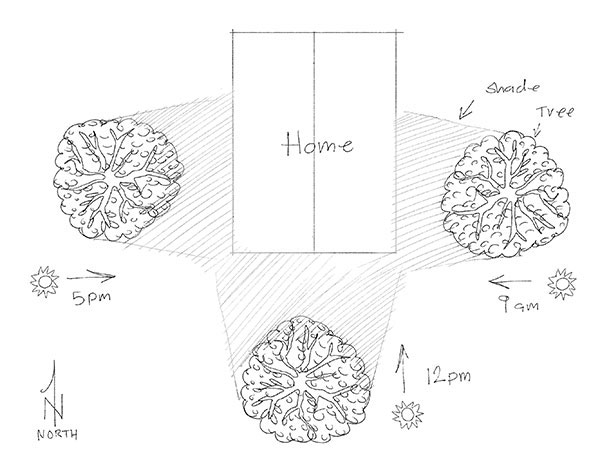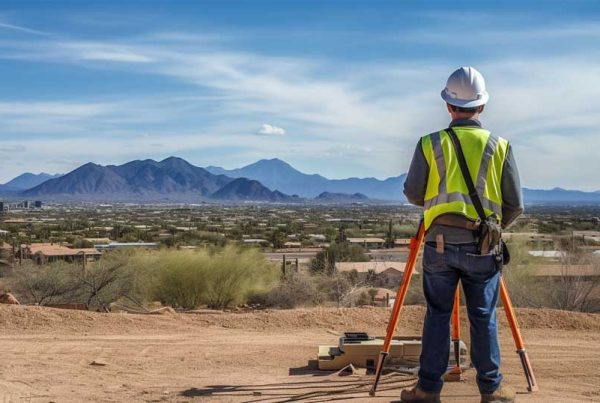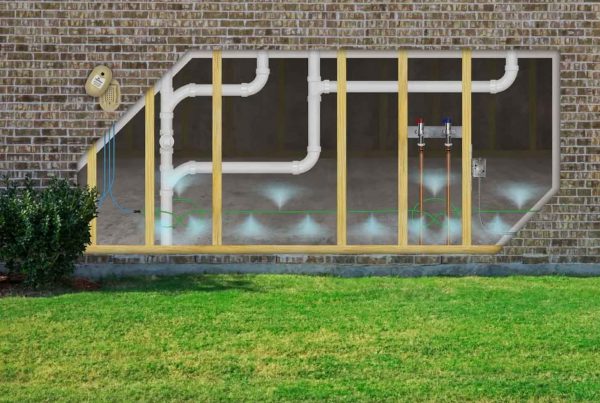
We all know Arizona is famous for its hot summer days—and if you live here, you’ve definitely felt it. That’s why it’s so important to think about how your home is oriented toward the sun and what strategies you’re using to protect it from Arizona’s intense heat. In this post, we’re diving into the idea of summer shading, a practical and essential part of building or designing energy-efficient homes in the desert.
Now, we can’t exactly put giant umbrellas over our houses (unfortunately!), but we do have the next best thing: trees. And it’s not just a good idea—it’s actually built into official green building practices. According to the National Green Building Standard, here’s what summer shading looks like:
“Planting installed to shade a minimum of 30% of building walls. To conform to summer shading, the effective shade coverage (five years after planting) is the arithmetic mean of the shade coverage calculated at 10 A.M. for eastward-facing walls, noon for southward-facing walls, and 3 P.M. for westward-facing walls on the summer solstice.”
(Source: 2020 National Green Building Standard 503.5.8 Landscape Plan)
Let’s break this down and talk about why it matters so much for Arizona homes.
The Exterior Conditions in Summer
While you’re enjoying the cool comfort of your air-conditioned home, your exterior walls are hard at work battling extreme temperatures. Your AC runs until it hits your desired temperature and then turns off—but the heat outside doesn’t stop. Slowly, exterior heat begins to creep back in through your walls, a process known as thermal bridging.
To better understand this, we ran some surface temperature tests around the Valley during peak summer. On a 105°F day, we measured surface temps of common building materials like roof tile, stucco, pavement, and decomposed granite—and what we found was shocking. While the air was 105°F, surfaces ranged from 135°F to 160°F, with the darkest pavement hitting the highest numbers.
That means while you’re sitting inside a nice 75-degree home, the exterior is baking at 140°F or more if it’s in direct sun. The more that exterior wall is exposed to the sun, the more heat it conducts inside—and the more work your AC has to do.
Why Summer Shading Matters
Think of it like this: would you rather stand in the full Arizona sun or take refuge under a shady tree? Your house feels the same way. Proper summer shading is one of the smartest ways to reduce heat gain, lower energy bills, and extend the life of your mechanical systems.
By shading the building’s exterior—especially the walls that take the brunt of the sun—you’re actively reducing the amount of thermal energy that tries to sneak into your home. That’s why tree placement and smart landscaping are part of the National Green Building Standard.
Where to Place Shade Trees
 In Arizona, the sun travels from east to west, staying high overhead in the summer and at a lower angle in winter. That means the east, south, and west sides of your home are getting the most intense exposure—especially the west side, which gets hit during the hottest part of the day.
In Arizona, the sun travels from east to west, staying high overhead in the summer and at a lower angle in winter. That means the east, south, and west sides of your home are getting the most intense exposure—especially the west side, which gets hit during the hottest part of the day.
When planting, it’s a great idea to work with a local landscape architect to map sun angles specific to your lot. The goal is to plant trees on these key sun-facing sides, keeping in mind that the west side is the highest priority. By year five, when trees start offering real canopy coverage, you’ll see a big difference in comfort and energy efficiency.
Smart Tree Placement Tips:
-
-
Keep trees a safe distance from the house to avoid damaging roots or overhanging limbs.
-
Avoid debris on roofs or in gutters, which can cause blockages and maintenance issues.
-
Prevent rodent access to the roof—roof rats are common in rural Cave Creek and surrounding areas.
-
Choosing the Right Trees for Summer Shading
Not all trees are created equal—especially in the desert. To make the most of your summer shading strategy, consider choosing native or drought-tolerant deciduous trees.
Deciduous trees provide lush shade in summer, then lose their leaves in winter, allowing more sunlight to warm your home when you want it. It’s a passive energy strategy that works year-round.
Popular deciduous trees that thrive in Arizona:
-
-
Desert Willow (Chilopsis linearis)
-
Arizona Walnut
-
Velvet Mesquite
-
Western Soapberry
-
Fan Tex Ash
-
Arizona Ash
-
Palo Brea
-
Museum Palo Verde
-
Just remember—leaf drop means a bit more cleanup in the fall. But the trade-off is improved energy performance and comfort all year long.
Shade More Than Just Your Home
The ground matters, too. Our surface temperature tests showed that decomposed granite soil can reach 150°F on a 105°F day. That heat doesn’t disappear at night—it radiates back up into the environment, increasing the ambient temperature around your home and yard.
Strategically planting trees around your entire property (not just next to your walls) can help block the sun from heating up the ground. This reduces overall radiant heat and creates cooler outdoor spaces for entertaining, relaxing, or gardening.
Plan for Outdoor Shade During Design
If you’re designing or building a new home, now’s the perfect time to think about your home’s orientation and patio placement in relation to the sun. For example, if you love hosting summer get-togethers, but don’t want the sun baking your guests, consider placing your main patio on the east side of the house.
This way, you get enjoyable morning light and increasing shade as the day goes on—keeping outdoor areas cooler and more comfortable during the hottest hours.
Conclusion: Building Efficiency Starts Outside
Energy efficiency isn’t just about what goes inside the walls. It’s about creating a whole-home system that works with the environment around it. Your landscape design, including how you implement summer shading, plays a huge role in your home’s comfort, performance, and long-term durability.
Whether you’re planting new trees, designing a new home, or just learning more about green building practices—small decisions like summer shading can have a big impact.
Want more energy-efficient building tips?
Follow us on social or sign up for our newsletter to learn how we design and build smarter, cooler homes in Arizona’s desert climate.
📬 Stay in the Loop
Want more useful insights like this?
Subscribe to the blog so you receive articles that are relevant to your home project.
Follow us on social media to stay updated with our latest tips and posts:
📘 Facebook @VistaMontanaBuilders
📸 Instagram @VistaMontanaBuilders








